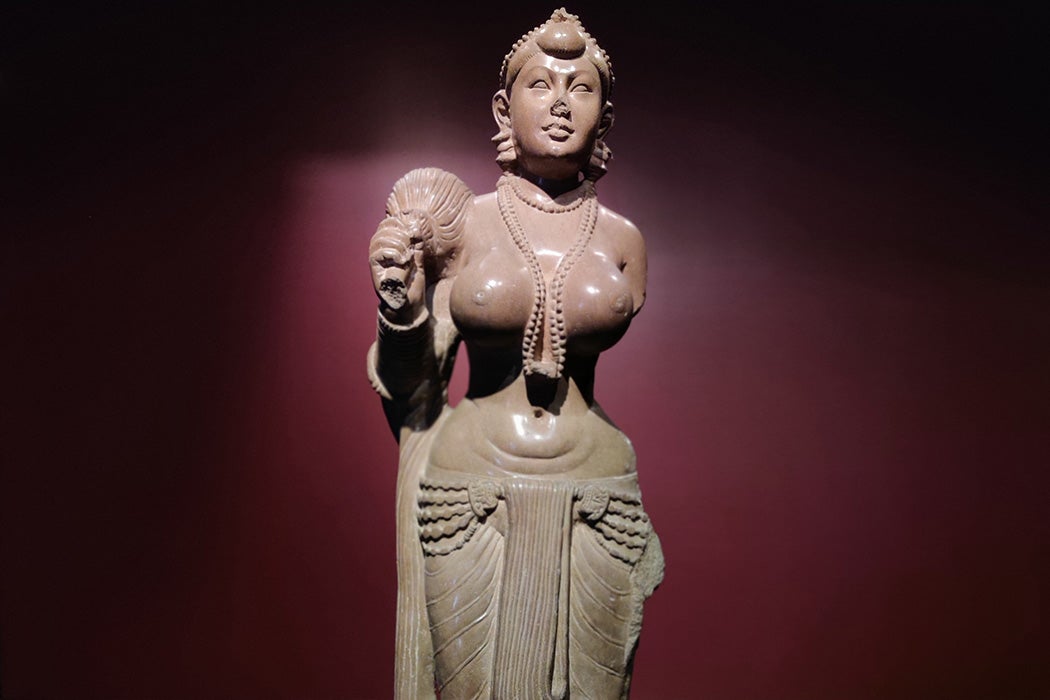The disposition of the contemporary city of Patna in Bihar, a state in the eastern region of India, is a far cry from the grandeur of its ancient counterpart, Pataliputra, the capital city of the Mauryan empire. Yet, Patna seeks to rise above its modern-day appearance by riding on its rich, historic legacy, embodied in the new Bihar Museum. This state-of-the-art institution houses a rich permanent collection of ancient artifacts unearthed from the region as well as temporary contemporary art exhibitions, which include the ongoing edition of the international Bihar Museum Biennale. There’s a lot to see, but the most famous exhibit here is a life-size statue called the Didarganj Yakshi.
With its voluptuous proportions and beautifully crafted finish, this stunning piece of stone masonry is considered one of the most noteworthy artifacts from ancient India. It’s officially known as the Didarganj Yakshi (a word that denotes a goddess of nature) and stands at a height of five foot two, having been sculpted out of Chunar sandstone. Owing to the sculpture’s highly polished finish and detailed finery, many scholars date it to the Mauryan dynasty around the third century BCE. However, other scholars believe this level of skill is better ascribed to a later stage of the art form that flourished in this region. Debate about its time period aside, most scholars refer to the figure as a religious one.
Historian and writer Doris Meth Srinivasan argues otherwise in her 2005 paper, “The Mauryan Ganika from Didarganj (Pataliputra),” published in the journal East and West. As she writes, the
ancient Pataliputra sculpture represents an image of a royal ganika. A beauteous female image, carved in the environs of the Mauryan capital, is imbued with the characteristics that mark her as a ganika, possibly the chief ganika—or the pratiganika—attached to the imperial court.
Before making this pronouncement, Srinivasan explains at length that the ganika is “a special type of courtesan.” A ganika shouldn’t be understood as a prostitute, she writes. “Indeed, the Indian tradition seems to have classified, and specified, the difference between the two.” The ganika, she asserts, was a “civilized public woman, proficient in the arts, winsome in her ways, and endowed with exceptional beauty and taste.” Those who didn’t possess her level of skill and talent were relegated to different categories of prostitutes.
She likens the ganika of ancient India to “the hetaera of ancient Greece or the Japanese geisha,” as she is “the exceptionally refined and cultivated courtesan.” Srinivasan points to texts like the Arthashastra from the second century BCE, and the Kamasutra and a play called the Mrcchakatika (The Little Clay Cart), both written in the fourth-to-fifth century CE, among others, as forming the basis of our knowledge of these skilled courtesans and their role in courtly life.
Based on this understanding, Srinivasan believes that the figurine represents a ganika and not a yakshi. Perhaps the confusion is understandable, as “a yakshi is a fertility figure and the female’s large globular breasts, tiny waist and broad hips are the typical attributes associated with the fecund female,” she writes.
Srinivasan points out that the figurine’s disposition provides further evidence of this misidentification. For instance, “the frontal stance of the Didarganj figure is not quite in samapada (weight equally distributed on both straight legs); her right knee bends slightly while her weight shifts onto the left leg.” This weight-shift leads to “a distinctive movement in the upper body.” Unlike the tribhanga pose [a triple-bend stance associated with classical dance] associated with yakshis, “the Didarganj female bends her torso with its beauteous breasts slightly forward.”
She also highlights the folds of fine material on the legs of the statue “covering and eliminating any outline of the pudendum” as a significant pointer towards the figure’s identity as a ganika. “In contrast, the attire of early yakshis displays, more than hides, the female’s sexual parts.”
Weekly Newsletter
Another significant aspect of the figure that sets her apart from a traditional yakshi is her fly whisk. Art historians Frederick Asher and Walter Spink particularly debunk the idea of her being a yakshi based solely on the presence of this device, which Srinivasan asserts is the “sine qua non of a courtesan.”
With the Bihar Museum gaining popularity as a cultural institution and drawing the attention of the international art fraternity, it’s perhaps time to revisit the traditional understanding of its most famous exhibit, led by the arguments of Srinivasan.
Three Tips for Teaching
Expand the discussion about the status of women using Priya Darshini’s study of women’s proprietary rights in ancient India.
Consider the cultural context of the museum. Use Amitava Kumar’s essay on coming of age in Patna in the 1970s or his 2014 book A Matter of Rats: A Short History of Patna to learn more about contemporary life in Patna.







